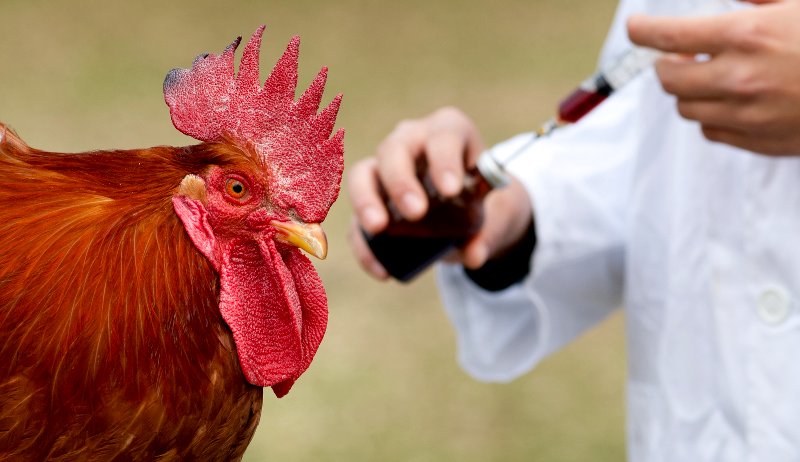
I’d just collected eggs from the Silkie coop when I noticed the blood. Just a few small drops lay scattered on the blades of grass near the nestbox. The drips increased in frequency, creating a path that led me straight to … Thomas, our resident bad-boy rooster. He stood by the Ameraucana coop, looking proud of himself, his comb freshly torn in several spots. As his cuts had already started to scab over, I ignored his injuries and went to help Jefferson, our blue Ameraucana roo. Jefferson crowed indignantly, blood streaming down his face from the wounds Thomas inflicted while poor Jefferson merely stood his ground.

No matter how vigilantly we care for our chickens, they still get hurt. Most of the time, their injuries are self-inflicted, the consequence of roo fights, pecking-order “discussions,” and encounters with sharp objects. Unfortunately, sometimes the wounds are much more serious, the result of an accident or, worse, an attack. Be prepared to render assistance to your feathered patients by following these guidelines to assess your birds’ injury level and provide them with the first aid they need.
Low-Level Injuries
Supplies
- Cotton balls
- Cotton swabs
- Sterile gauze
- Veterinary tape
- Blu-Kote
- Corn Starch or Styptic Powder
- Nail clippers
- Shears
- Tweezers
Your feathered kids will accumulate their share of life’s little bumps and bruises. Just like the low-level injuries of a human child, these ouchies will need first aid to prevent infection or worsening of the wound. Treating abrasions and lacerations in birds follows the same basic guidelines as with people: Clean the injury, then keep it clean. The key difference is that (most) humans don’t spend the day scratching in dirt, dust and droppings. Carefully clean the grime away with fresh water, using cotton balls for superficial dirt and swabs for extricating any grit stuck to a cut. If a cut is still freely bleeding, sprinkle in some corn starch to speed clotting, then gently wash the corn starch away. Pat the injury dry with sterile gauze, then apply Blu-Kote (or a similar veterinary germicide) to seal the wound, protect it from infection and cover the raw redness with blue to keep away curious chickens.
If an abrasion or laceration is large, cover it with sterile gauze after applying Blu-Kote, then use veterinary tape to keep the gauze firmly in place. Make sure the veterinary tape is secure but not so tightly wrapped that it compromises circulation.
Here are some other minor injuries and tips for treating them.
- Broken feather shaft: Snip clean with shears.
- Broken talon/nail: Clip clean with nail clippers but do not clip past the “quick,” or bloodline.
- Chipped beak: Trim the jagged edge as carefully as possible with clippers or shears.
- Splinter: Remove with tweezers then treat as if it were a cut.
Medium-Level Injuries
Supplies
- Wire snips
- Soldering iron
- Matches
- Sewing needles
- Nylon thread
- String
Be prepared to help your birds when they bring home something more serious than a scrape. I noticed that Ebony Orpington wasn’t scampering around the yard at her typical trot and worried that she’d become egg-bound. By the next day, she noticeably lagged behind her friends. Certain that something was wrong, I brought her to our exam table and began a systematic check. When I lifted her right wing, Ebony shuddered—as did I. A chunk of flesh about the width of a plum was missing, roughly ripped away. (Our neighbor later informed us she’d trapped a feral cat, the probable culprit, in the vicinity of Ebony’s favorite hangout.) After gently cleaning the wound and trimming away tattered sections of skin, I sterilized a needle with a lit match, then carefully sewed Ebony’s gaping injuries shut. Applications of Blu-Kote, gauze and vet tape followed. Ebony has been living in our hospital tractor since, slowly recuperating.

The wound Nestle Welsummer showed us several summers ago was only somewhat less appalling: One of her toes was withered and partially hanging off her foot. The toe had to go. I enlisted my oldest, Michael, a vet-school student, to assist with the amputation. While he held Nestle, I tied off the shriveled toe with string, severed it with the snips, then cauterized the wound with the soldering iron. Nestle was scampering around within days.
High-Level Injuries
Sadly, some injuries might be too severe to be treated. Prepare for this eventuality; don’t wait until it happens to gather your resources. Should your bird be maimed or otherwise wounded to the point of needing euthanasia, having everything in place will make this difficult time progress.
If you wish to ease your animal’s suffering yourself, determine the best method. Websites such as Small Animal Euthanasia at Home will walk you through the process. Tell your family members what’s about to take place so they aren’t taken by surprise, and check your local ordinances for regulations regarding domestic-animal death and disposal.
Can’t bring yourself to put down your bird? Find a local veterinary clinic that will accept exotic animals and ask for its hours of operation and euthanasia fees. This way, should you someday need the veterinarian’s services, you have the information on hand.
Regardless of whether your chicken has a minor abrasion, a severe wound or a life-threatening injury: If you do not feel comfortable rendering first aid—or if you’re not sure of how best to treat your bird—don’t. Your doubt and indecision can easily make a bad situation much worse.




